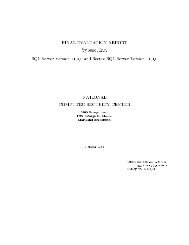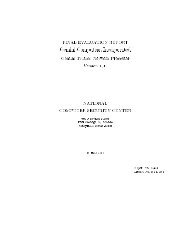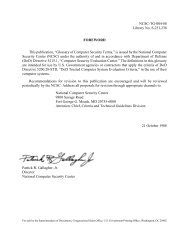Page 1 A Guide to the Procurement of Trusted Systems: An ... - csirt
Page 1 A Guide to the Procurement of Trusted Systems: An ... - csirt
Page 1 A Guide to the Procurement of Trusted Systems: An ... - csirt
You also want an ePaper? Increase the reach of your titles
YUMPU automatically turns print PDFs into web optimized ePapers that Google loves.
attitude should be "Show me, please" throughout <strong>the</strong> test effort. For <strong>the</strong><br />
internal TCB-provided security protection features, DoD 5200.28-STD<br />
requirements should be reviewed for testing each division/class. A team <strong>of</strong><br />
experts should be assembled <strong>to</strong> help test. Also, Chapter 5 <strong>of</strong> this document,<br />
"Security Test and Evaluation," should be reviewed.<br />
3.3.3.4 CONFIGURATION MANAGEMENT<br />
Configuration Management (CM) for TCB s<strong>of</strong>tware is only required for TCB<br />
Classes B2 and above. However, CM should be required for all acquisitions,<br />
whenever possible. CM is <strong>the</strong> only way <strong>to</strong> achieve a structured and<br />
disciplined approach <strong>to</strong> s<strong>of</strong>tware management, regardless <strong>of</strong> <strong>the</strong> TCB division/<br />
class. The situation is likely that some CM will be required in every program.<br />
The requirement extends <strong>to</strong> <strong>the</strong> TCB s<strong>of</strong>tware by including a Statement <strong>of</strong> Work<br />
task. The Program Manager should also participate in <strong>the</strong> Configuration Control<br />
Board (CCB), which is <strong>the</strong> committee that reviews all changes <strong>to</strong> established<br />
baselines. Note that <strong>the</strong> documented procedures for control <strong>of</strong> changes do not<br />
need <strong>to</strong> be as extensive for <strong>the</strong> lower TCB division/classes (C1 through B1).<br />
Configuration control must extend <strong>to</strong> distribution, delivery, installation,<br />
Operation, and maintenance.<br />
3.3.3.5 AUDIT<br />
Auditing <strong>of</strong> security-relevant events is required for all TCB division/<br />
classes (C2 and above). The early identification <strong>of</strong> audit requirements and<br />
strategy is necessary <strong>to</strong> ensure that <strong>the</strong> accountability requirements are<br />
satisfied for <strong>the</strong> TCB division/class, and <strong>to</strong> ensure <strong>the</strong>y are included in <strong>the</strong><br />
TCB design. The NSA publication NCSC-TG-001,"A <strong>Guide</strong> To Understanding Audit In<br />
<strong>Trusted</strong> <strong>Systems</strong>," describes <strong>the</strong> specific audit requirements for each TCB<br />
division/class, including <strong>the</strong> events that must be audited and <strong>the</strong> specific<br />
information that must be recorded.<br />
3.3.3.6 PASSWORD GENERATION AND MANAGEMENT<br />
One <strong>of</strong> <strong>the</strong> major requirements <strong>of</strong> all TCB division/classes is accountability.<br />
The CSC-STD-002-85, "DoD Password Management <strong>Guide</strong>line," and NCSC-TG-017, "A<br />
<strong>Guide</strong> <strong>to</strong> Understanding Identification and Au<strong>the</strong>ntication," provide sound<br />
practices that will help satisfy <strong>the</strong> accountability requirement. Ensure<br />
accountability is included in all AIS RFP requirements. Also ensure <strong>the</strong><br />
information provided in <strong>the</strong> <strong>Trusted</strong> Facility Manual and Security Features<br />
User's <strong>Guide</strong> is consistent with <strong>the</strong> principles in this guideline.<br />
3.3.3.7 TCB IMPLEMENTATION CORRESPONDENCE<br />
The process <strong>of</strong> assuring that <strong>the</strong> TCB is "properly done" is called<br />
"correspondence." The technique used is <strong>to</strong> map <strong>the</strong> TCB design back <strong>to</strong> <strong>the</strong><br />
security policy model at <strong>the</strong> B1 and above levels. In addition, <strong>the</strong> TCB Class<br />
A1 requirement calls for mapping <strong>the</strong> TCB design down <strong>to</strong> <strong>the</strong> TCB source code.<br />
3.3.4 CLASSIFIED SOFTWARE<br />
If any <strong>of</strong> <strong>the</strong> s<strong>of</strong>tware being developed is classified, be sure <strong>to</strong> check Block<br />
11c, Receipt and Generation <strong>of</strong> Classified Documents and O<strong>the</strong>r Material, <strong>of</strong> <strong>the</strong><br />
DD Form 254, Contract Security Classification Specification. <strong>Trusted</strong><br />
<strong>Page</strong> 44







